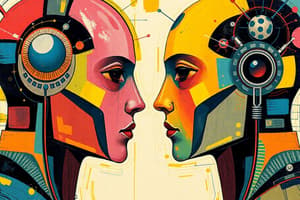Podcast
Questions and Answers
Which activity accurately reflects the functionality of an 'agent'?
Which activity accurately reflects the functionality of an 'agent'?
- Ignoring input from external sources.
- Remaining static, irrespective of alterations in the surrounding environment.
- Operating solely based on pre-set guidelines and commands.
- Detecting modifications within its environment and subsequently reacting. (correct)
In the context of robotics, what is the primary function of 'actuators'?
In the context of robotics, what is the primary function of 'actuators'?
- To process collected data.
- To execute actions. (correct)
- To perceive environmental changes.
- To store operational memory.
Which component allows a robot to gather information from its surroundings?
Which component allows a robot to gather information from its surroundings?
- Power supply
- Processors
- Sensors (correct)
- Actuators
What constitutes the 'architecture' of an agent?
What constitutes the 'architecture' of an agent?
What defines an agent's level of autonomy?
What defines an agent's level of autonomy?
Which of the following demonstrates 'high autonomy' in a robotic system?
Which of the following demonstrates 'high autonomy' in a robotic system?
What is the primary purpose of the PEAS framework in robotics?
What is the primary purpose of the PEAS framework in robotics?
According to the PEAS framework, which component clarifies the agent's operational setting?
According to the PEAS framework, which component clarifies the agent's operational setting?
In the context of robotics, what does 'ODESA' primarily classify?
In the context of robotics, what does 'ODESA' primarily classify?
Which term describes an environment where an agent has access to all necessary information for decision-making?
Which term describes an environment where an agent has access to all necessary information for decision-making?
In what type of environment do past actions influence future situations?
In what type of environment do past actions influence future situations?
What distinguishes 'robotics' from 'robots'?
What distinguishes 'robotics' from 'robots'?
What is a key characteristic of a 'robot'?
What is a key characteristic of a 'robot'?
In what context was the term 'robot' originally introduced?
In what context was the term 'robot' originally introduced?
What fundamental question must a mobile robot address to navigate effectively?
What fundamental question must a mobile robot address to navigate effectively?
Which option is a key benefit of deploying robots in industrial settings?
Which option is a key benefit of deploying robots in industrial settings?
What is a principal disadvantage of using robots in the workforce?
What is a principal disadvantage of using robots in the workforce?
Which type of robot maintains a fixed position while operating?
Which type of robot maintains a fixed position while operating?
Which characteristic is most applicable to wheeled robots?
Which characteristic is most applicable to wheeled robots?
What is a key advantage of legged robots compared to wheeled robots?
What is a key advantage of legged robots compared to wheeled robots?
What is a significant challenge in the design of aquatic robots?
What is a significant challenge in the design of aquatic robots?
What application is most associated with flying robots?
What application is most associated with flying robots?
Which factor primarily differentiates remote-control robots from autonomous robots?
Which factor primarily differentiates remote-control robots from autonomous robots?
In what sector are robots commonly deployed for hazardous and repetitive tasks?
In what sector are robots commonly deployed for hazardous and repetitive tasks?
In the PEAS framework, consider a robot designed for cleaning a home. If the 'Performance Measure' is defined as 'percentage of area cleaned,' what would be a suitable example of an 'actuator' for this robot?
In the PEAS framework, consider a robot designed for cleaning a home. If the 'Performance Measure' is defined as 'percentage of area cleaned,' what would be a suitable example of an 'actuator' for this robot?
Consider a robotic system deployed in a factory to sort products on a conveyor belt. The robot uses a camera to identify the products, a robotic arm to pick and place them into different bins, and a central computer for processing. If the environment is 'partially observable' due to occasional visual obstructions, what strategy would BEST improve system reliability?
Consider a robotic system deployed in a factory to sort products on a conveyor belt. The robot uses a camera to identify the products, a robotic arm to pick and place them into different bins, and a central computer for processing. If the environment is 'partially observable' due to occasional visual obstructions, what strategy would BEST improve system reliability?
A robot is designed to compete in a maze-solving competition. The maze is reconfigured daily, and the robot must learn the maze layout on its own each day. Which combination of attributes from the ODESA framework BEST describes the robot's operational environment?
A robot is designed to compete in a maze-solving competition. The maze is reconfigured daily, and the robot must learn the maze layout on its own each day. Which combination of attributes from the ODESA framework BEST describes the robot's operational environment?
Suppose you are designing a robot to autonomously explore the surface of a distant planet. The robot must collect soil samples, analyze them, and then decide where to move next based on the analysis results. Considering the constraints of long communication delays and limited battery life, what design aspect is MOST critical for this robot's success?
Suppose you are designing a robot to autonomously explore the surface of a distant planet. The robot must collect soil samples, analyze them, and then decide where to move next based on the analysis results. Considering the constraints of long communication delays and limited battery life, what design aspect is MOST critical for this robot's success?
Imagine a robot designed for bomb disposal. It needs to navigate complex, unpredictable environments, identify potential threats, and manipulate delicate mechanisms. Given the high stakes, what is the MOST critical performance measure for this robot that would outweigh other factors like speed or energy efficiency?
Imagine a robot designed for bomb disposal. It needs to navigate complex, unpredictable environments, identify potential threats, and manipulate delicate mechanisms. Given the high stakes, what is the MOST critical performance measure for this robot that would outweigh other factors like speed or energy efficiency?
You are tasked with creating a robot that can both explore deep underwater environments and also fly in the air to scout out locations before diving. Given the drastically different design constraints for underwater pressure resistance versus aerial maneuverability, what is the MOST innovative approach to build this robot, considering existing technologies?
You are tasked with creating a robot that can both explore deep underwater environments and also fly in the air to scout out locations before diving. Given the drastically different design constraints for underwater pressure resistance versus aerial maneuverability, what is the MOST innovative approach to build this robot, considering existing technologies?
Flashcards
What is an Agent?
What is an Agent?
An agent senses surroundings and responds using sensors and actuators.
What do Sensors do?
What do Sensors do?
Collect information from the surroundings.
What do Actuators do?
What do Actuators do?
Perform actions based on information.
What is the Agent Program?
What is the Agent Program?
Signup and view all the flashcards
What is Agent Architecture?
What is Agent Architecture?
Signup and view all the flashcards
Formula for an Agent
Formula for an Agent
Signup and view all the flashcards
What is Autonomy in Robotics?
What is Autonomy in Robotics?
Signup and view all the flashcards
What if a robot follows pre programmed rules?
What if a robot follows pre programmed rules?
Signup and view all the flashcards
What if a robot learns from experience?
What if a robot learns from experience?
Signup and view all the flashcards
What is Performance Measure in PEAS?
What is Performance Measure in PEAS?
Signup and view all the flashcards
What is Environment in PEAS?
What is Environment in PEAS?
Signup and view all the flashcards
What are Actuators in PEAS?
What are Actuators in PEAS?
Signup and view all the flashcards
What are Sensors in PEAS?
What are Sensors in PEAS?
Signup and view all the flashcards
What does Fully Observable mean?
What does Fully Observable mean?
Signup and view all the flashcards
What does Partially Observable mean?
What does Partially Observable mean?
Signup and view all the flashcards
What does Predictable mean?
What does Predictable mean?
Signup and view all the flashcards
What does Random mean?
What does Random mean?
Signup and view all the flashcards
What does One-time (Episodic) mean?
What does One-time (Episodic) mean?
Signup and view all the flashcards
What does Ongoing mean?
What does Ongoing mean?
Signup and view all the flashcards
What does Static Environment mean?
What does Static Environment mean?
Signup and view all the flashcards
What does Dynamic Environment mean?
What does Dynamic Environment mean?
Signup and view all the flashcards
What does Single Agent mean?
What does Single Agent mean?
Signup and view all the flashcards
What does Multi-Agent mean?
What does Multi-Agent mean?
Signup and view all the flashcards
What is Robotics?
What is Robotics?
Signup and view all the flashcards
What is a Robot?
What is a Robot?
Signup and view all the flashcards
What can a robot do?
What can a robot do?
Signup and view all the flashcards
Three Questions Robots Ask
Three Questions Robots Ask
Signup and view all the flashcards
What is Stationary Robot?
What is Stationary Robot?
Signup and view all the flashcards
What is Wheeled Robots?
What is Wheeled Robots?
Signup and view all the flashcards
What is Legged Robots?
What is Legged Robots?
Signup and view all the flashcards
Study Notes
- Robotics and Intelligent Systems is an area of study
What is an Agent?
- An agent can sense its surroundings and respond to them
- Sensors gather information, and actuators take action
- Human agents use eyes, ears, and other organs as sensors
- Human agents use hands, legs, mouth, and other body parts as actuators
- Robotic Agents use cameras and infrared range finders as sensors
- Robotic Agents use motors as actuators
Agents and Environments
- An agent interacts with its environment by sensing and acting
- Sensors collect information from the surroundings
- Actuators perform actions based on the information collected
- Agent program is software that controls how an agent makes decisions
- Agent architecture is the physical system that runs the program
- Agents are a combination of Architecture and Programs
PEAS Framework
- Before designing an intelligent agent, its PEAS must be defined
- Defining PEAS helps in building the right agent for the right task
- PEAS means:
- Performance Measure – Defines how well the agent is doing
- Environment – The surroundings where the agent operates
- Actuators – The parts that perform actions
- Sensors – The parts that collect information
- Self-driving car example:
- Safe driving, fast arrival as performance measures
- Roads, traffic, weather conditions as the environment
- Steering, acceleration, brakes as actuators
- Cameras, radar, GPS as sensors
- Part-picking robot example:
- Percentage of parts correctly binned as a performance measure
- Conveyor belt with parts and bins is the environment
- Jointed arm and hand are the actuators
- Camera and joint angle sensors are the sensors
Environment Types (ODESA)
- Fully Observable: The agent can see everything it needs to make decisions
- Partially Observable: The agent has limited information and may need to guess
- Predictable (Deterministic): The agent always knows what will happen next
- Random (Stochastic): The outcome is uncertain and things can change unexpectedly
- One-Time (Episodic): Each task is separate; past actions don't matter
- Ongoing (Sequential): An agent's actions affect future situations
- Static: The environment stays the same while the agent is thinking
- Dynamic: The environment changes, even if the agent isn't acting
- Single-Agent: Only one agent is working in the environment
- Multi-Agent: Many agents interact, either cooperatively or competitively
- Knowing the environment type helps design smarter agents
- Some environments require better sensors and decision-making skills
What is a Robot?
- Robotics is the study and development of robots
- Robots are the actual machines that perform tasks
- The word "robot" was first used by Czech writer Karel Čapek in his play Rossum's Universal Robots in 1920
- It comes from the Slavic word "robota", meaning work
- A robot is a machine that can be programmed to perform different tasks
- Robots can move objects, use tools, or complete actions based on instructions
- This definition comes from the Robot Institute of America
Mobile Robotics
- The 3 most important questions in Mobile Robotics:
- Where am I?
- Where am I going?
- How do I get there?
- To answer the questions, robots must:
- Have a model of the environment
- Perceive and analyze the environment
- Locate their position/situation within it
- Plan and execute movement
Advantages of Robots
- Robots don't get tired and can work all day and night without resting
- Robots can handle risky tasks that are unsafe for humans
- Robots can work on their own and don't always need humans to control them
- They work fast, accurately, and don't make mistakes
- Used in factories to build cars, planes, and other products
Disadvantages of Robots
- Building and maintaining them costs a lot of money, so robots are expensive
- Robots stop working if there is no electricity because they need power
- Some workers may lose their jobs if robots replace them
- Regular maintenance which can be costly is needed to repair robots
- If hackers or bad people control them, they could cause harm and be dangerous
- Mistakes in programming or malfunctions can make some robots are not safe
Types of Robots (Locomotion)
- Stationary Robots stay in one place
- Wheeled Robots move using wheels
- Legged Robots walk on legs
- Swimming Robots move in water
- Flying Robots fly in the air
- Remote-control robots need a person to control them
Stationary Robots (Industrial Robot)
- Do not move, staying in one place and working from there
- Includes robotic arms, CNC machines, and welding robots
- welding robots and CNC robots are examples
- Factories use welding robots for joining metal parts
- Uses CNC robots to cut and shape materials
- Types of stationary Robots:
- Cartesian Robots: Move in straight lines (X, Y, Z directions)
- Cylindrical Robots: Move in a circular motion
- Spherical Robots: Rotate around a point
- SCARA Robots: Used for assembly tasks
- Robotic Arms: Have joints to move like a human arm
- Parallel Robots: Have multiple arms working together
Wheeled Robots
- Move using wheels on the ground
- Compared to robots with legs or tracks, are simple and easy to build
- Work best on flat and smooth surfaces
- Cannot climb obstacles like stairs or rough terrain
- Have trouble moving on slippery or uneven surfaces
- Single-wheel (ball) robots move in all directions
- Two-wheeled robots balance on two wheels (like Segways)
- Three or more wheeled robots are more stable and used in industries
Legged Robots
- Move using legs instead of wheels
- Can walk on rough ground where wheeled robots fail
- Need more energy and harder to build than wheeled robots
- Bipedal Robots walk on two legs (like humans)
- Tripedal Robots have three legs
- Quadrupedal Robots walk on four legs (like dogs)
- Hexapod Robots have six legs (like insects)
- Other Legged Robots can have more legs for better stability
Aquatic Robots (Swimming Robots)
- Move in water and can sail, dive, or crawl underwater
- Difficult to build due to water damage to electronics
- Fish robots look and move like fish
- Robot boats float and sail on water
- Swimming robots (submarines) dive and explore deep water
- Underwater crawling robots move along the ocean floor
Flying Robots
- Move in the air
- They are used for search and rescue, surveillance, and exploration
- Can reach dangerous places where humans cannot go
- Air Balloon Robots float using balloons
- Rotary Wing Robots fly like helicopters (e.g., drones)
- Wing Flapping Robots move like birds by flapping wings
- Airplane Robots fly like airplanes with fixed wings
Remote-Control Robots
- Remote-control robots are controlled by humans using a remote device
- The operator has full control over the robot's movements and actions
- Wired Remote Control uses cables/wires
- Wireless Remote Control is without wires, allowing the robot to move freely
Robots Based on Applications
- Industrial Robots:
- Used in factories for tasks like welding, painting, and assembly
- Work in dangerous or repetitive jobs with high accuracy
- Military Robots:
- Used for surveillance, bomb disposal, and combat support
- Help in dangerous missions without risking human lives
- Social Service Robots:
- Assist in healthcare, elderly care, and customer service
- Humanoid robots in hospitals and Al assistants are used
- Space Robots:
- Used for exploring planets and satellites
- Mars rovers like Perseverance and Curiosity
- Agricultural Robots:
- Help in planting, harvesting, and monitoring crops
- Drones for spraying pesticides and analyzing soil health
Key Takeaway
- Robots are designed for specific tasks to make work safer, faster, and more efficient </content
Studying That Suits You
Use AI to generate personalized quizzes and flashcards to suit your learning preferences.




